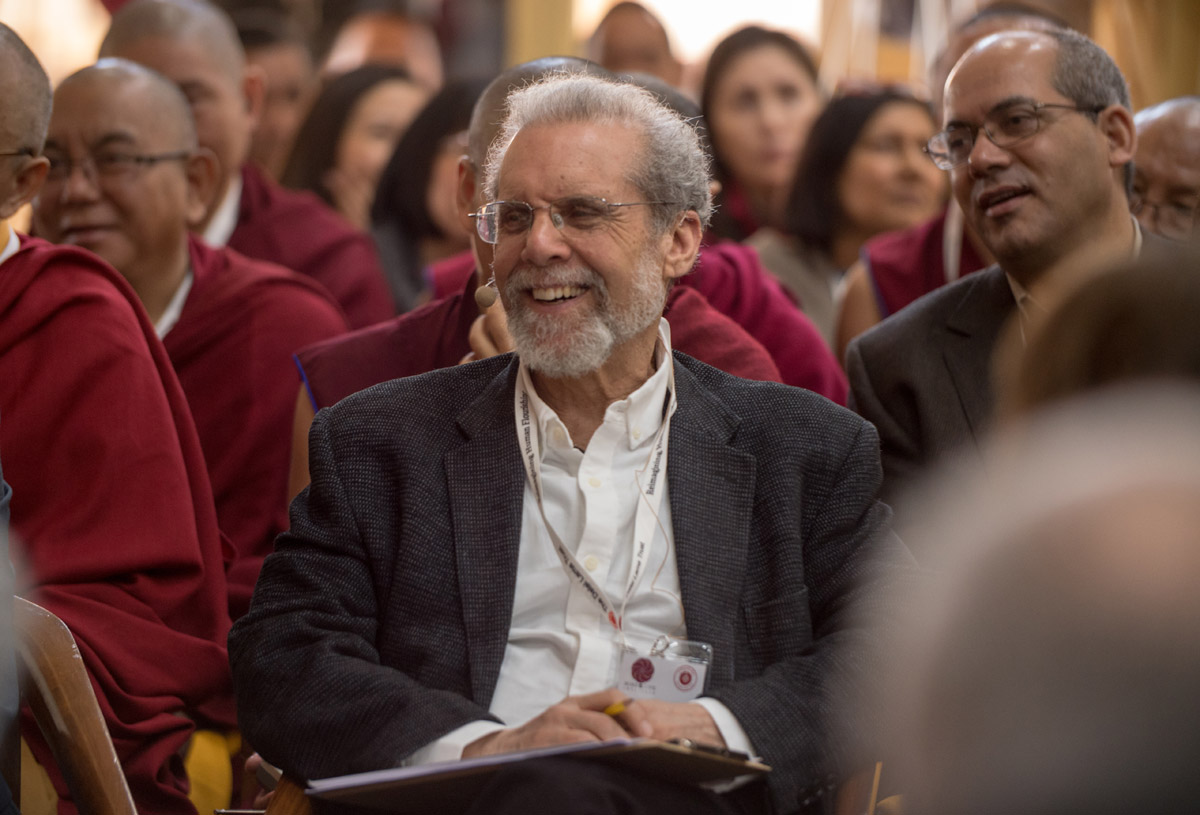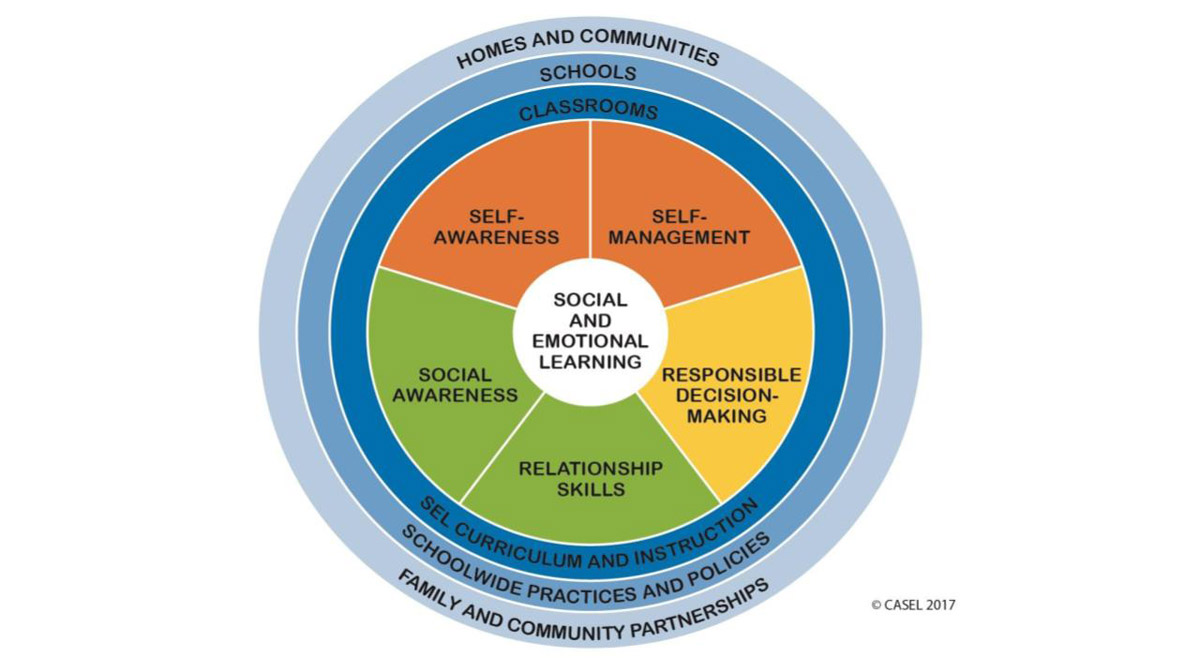In the United States and other nations, rising rates of anxiety and depression among adolescents underscore the need to better equip an emerging generation with the tools to navigate a fast-changing world and complex emotions.
Conference presenters explored recent trends and how social and emotional learning (SEL) can better prepare students for their present and a future that can be hard to predict. Evidence was presented on the power of SEL to nurture self-awareness, manage attention, and promote well-being.
“There is suffering—a lot of suffering—because of emotion,” said the Dalai Lama to psychologist Richard Davidson, a renowned contemplative science researcher and Director of the University of Wisconsin-Madison Center for Healthy Minds. “We are facing some kind of crisis of emotion!” the Dalai Lama exclaimed gravely.
To illustrate the Dalai Lama’s point, Davidson projected a series of PowerPoint charts on several large overhead screens. The first chart showed, for the years 2004 to 2015 in the United States, the percentage of young people between 12 and 17 years of age who experienced an episode of major depression during the previous 12 months. “You can see these trends going up in every age group,” Davidson reported. The second chart showed the gender breakdown. “In 2015 the gender difference was greater than it has ever been since we have been measuring this,” he said. “The disparity is caused by females showing a big increase in depression.” The third chart showed Center for Disease Control statistics for adolescent suicides in the United States between 2007 and 2014. The number of adolescent suicides rose steadily, more than doubling over those seven years. Davidson got to the point: “Well-being is an urgent public health need.”

Slide image © Richard Davidson.
What is the Way Forward?
Investing more money in traditional research is not the answer, Davidson argued. He cited the former Director of the National Institute of Mental Health in the United States, Dr. Tom Insel, who declared that over his 13-year term, during which he was responsible for a research budget of $20 billion, “I don’t think we moved the needle in reducing suicide, reducing hospitalizations, or improving recovery for tens of millions of people who have mental illness.” For Davidson and his colleagues in Dharamsala, social and emotional training offers a powerful set of tools for countering pervasive unhappiness.
Trends in society-wide responses to social ills change over the decades. “We see an evolution in what we are doing,” Davidson stated, “from the treatment of disorders to prevention of those disorders to cultivation of healthy qualities of mind.” This shift goes beyond simply preventing or treating illness, he said, to fostering well-being and virtue.
The SEL movement is both a product of this evolution and a cause of it. Renowned psychologist and science writer Daniel Goleman explained why. Goleman is author of the worldwide bestseller Emotional Intelligence, which catalyzed the SEL movement, and co-author with Richard Davidson of the recent book Altered Traits: Science Reveals How Meditation Changes Your Mind, Brain, and Body. In the 1980s, Goleman recounted, the United States government promoted a series of prevention programs—the ‘war on violence,’ the ‘war on suicide,’ and the ‘war on drugs.’ Some worked well; others worked less well, Goleman said. For example, one drug prevention program sent police into schools. They showed drugs to children to explain that drugs were dangerous. Drug use among the youth actually increased during that time.

Researchers then conducted a study of these prevention programs to try to figure out what made some programs succeed and others fail. “They found that the active ingredients were the same no matter what you are trying to prevent,” Goleman reported. “It was building children’s capacity for flourishing: for well-being, self-awareness, self-management, empathy, and social skill.”
Some of the researchers who conducted that study became pioneers of SEL. One of them, Roger Weissberg—then a professor of psychology at Yale University—co-founded an organization called the Collaborative for Academic Social and Emotional Learning (CASEL). “That’s the group that has been promoting most of the programs you’ll hear about,” Goleman told the Dalai Lama. (Goleman is also a CASEL co-founder.)

Image © CASEL.
Implicit to SEL is a theory of social change. To explain to the Dalai Lama how this type of training can improve society at large in terms he would understand, Goleman quoted, well, the Dalai Lama. “You said to some students in Vancouver,” Goleman recounted, “‘this kind of education—education of the heart—can teach affection and a sense of responsibility. It is important for your own happiness and for your family’s happiness. As families become more compassionate, society becomes more compassionate. This is for the survival of humanity.’”
What Makes Us Who We Are?
In a 2013 article in Time, Goleman reported on a 2011 New Zealand study that followed 1,000 children from birth until adulthood. (“Forget Delayed Gratification: What Kids Really Need is Cognitive Control,” October 7, 2013) The researchers wanted to know if the degree of self-control (see footnote) children have in childhood predicted their adult levels of health, wealth, substance abuse behavior, or criminal offenses. As Goleman reports, “By their early 30s, their ability to manage attention predicted their financial success and their health better than did their IQ or the wealth of their family of origin.” Significantly, children who started out with poor cognitive control but improved it during childhood, Goleman wrote, “fared as well as children who had high levels all along.” Goleman cited this study to the Dalai Lama as evidence that “social emotional learning can have a lasting impact beyond what our genes give us.”
Can children who have grown up in underprivileged families and communities, particularly those who have experienced trauma, benefit the same as children from more economically-stable backgrounds? What is the interplay between genetics and environmental factors in determining child development outcomes? These subjects are discussed in Chapter 4 “Nature and Nurture in Human Development.”
The term self-control begs clarification. The New Zealand researchers explain in their report on the study that self-control is an umbrella term used differently by investigators in different fields. They seem to use it to mean the children’s ability “to delay gratification, control impulses, and modulate emotional expression.” Goleman’s article about the study translates the term as “cognitive control,” which he defines as “the ability to manage attention.” At the conference he further defined cognitive control as “the ability to move your attention here or there, to have positive or negative thoughts, and to manage your emotions.” These arguably could be different interpretations.
